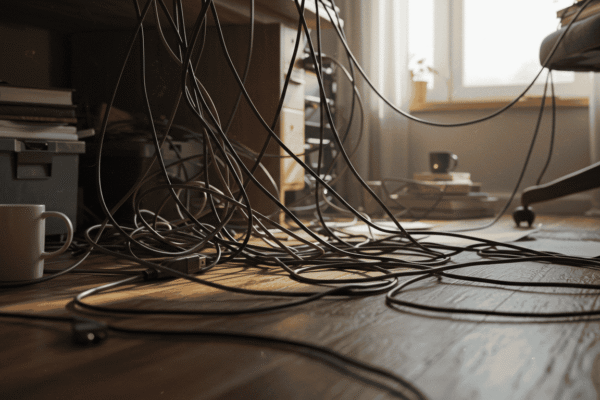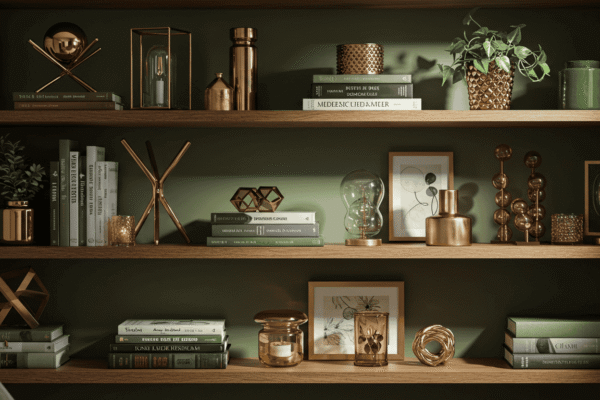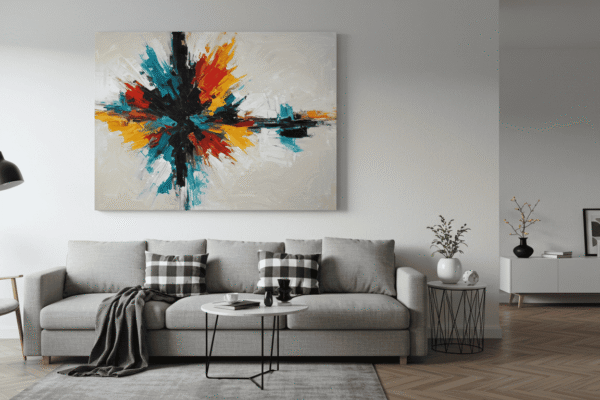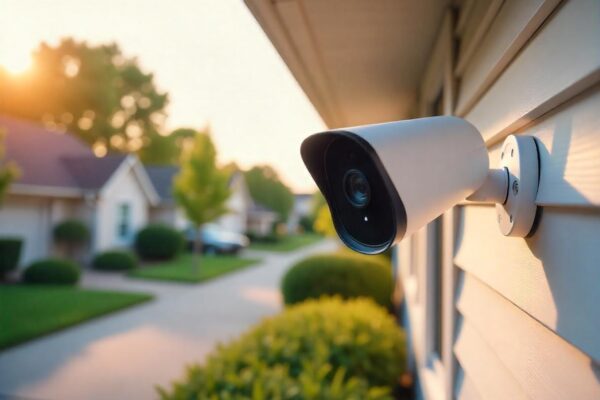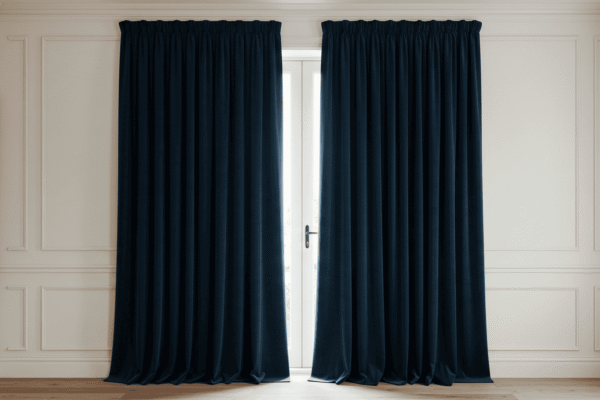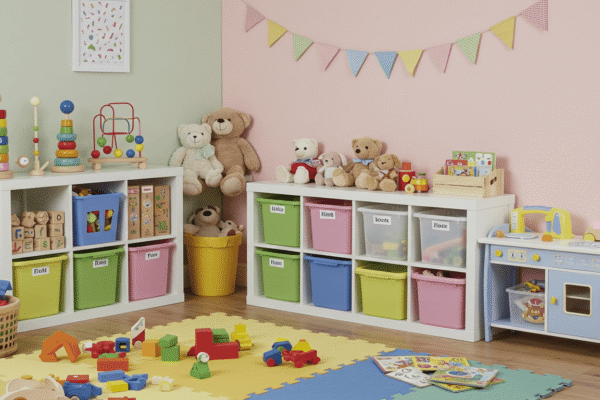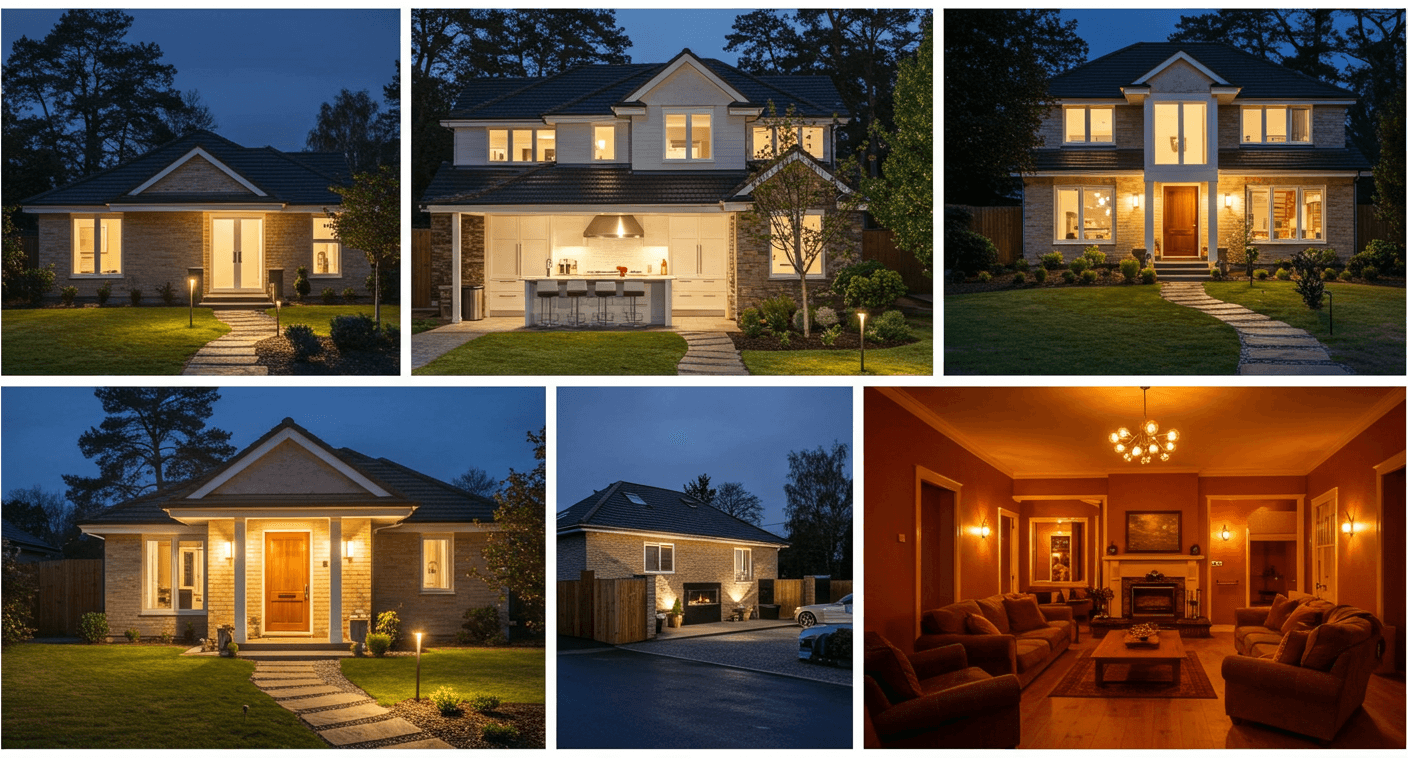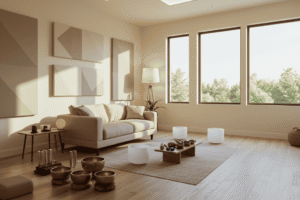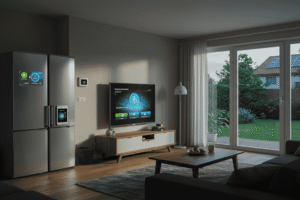Energy-Saving Lighting Ideas are more than just a trend—they’re a smart, long-term strategy for anyone looking to reduce electricity bills and live more sustainably. Whether you’re switching to energy-efficient lighting, experimenting with smart lighting controls, or simply rethinking how light is used in each room, there are plenty of creative ways to cut costs without compromising comfort. In this guide, we’ll explore practical and inspiring lighting ideas that will help you save energy, enhance your home’s ambiance, and make your lighting setup work harder (and smarter) for you.
Why Energy-Saving Lighting Matters: Beyond Just Lower Bills
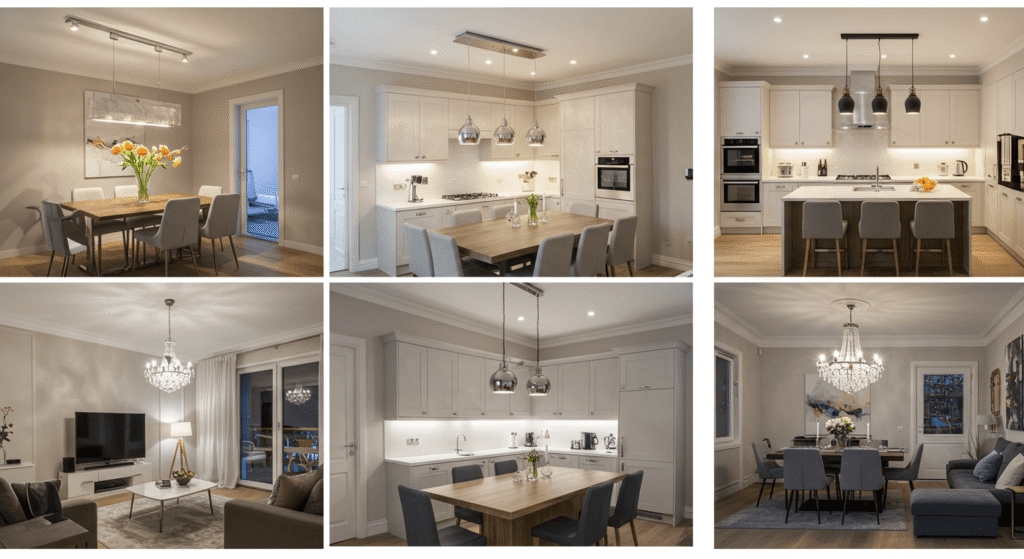
Choosing energy-saving lighting ideas isn’t only about trimming down monthly bills—though that’s a nice bonus. It’s about understanding the broader impact of lighting on your home, wallet, and the planet. Traditional lighting methods consume more power, generate more heat, and contribute to long-term energy waste. Let’s explore how your everyday lighting choices play a much bigger role than you might think.
Environmental Impact: How Lighting Affects Your Carbon Footprint
Lighting accounts for a significant share of household energy use, and using inefficient bulbs contributes directly to higher carbon emissions. Traditional incandescent bulbs waste a large portion of energy as heat, which not only drives up energy usage but also increases cooling needs in warmer months. In contrast, energy-efficient lighting like LEDs uses far less power, resulting in reduced demand on power plants and a smaller environmental footprint.
Switching to eco-friendly lighting solutions helps lower greenhouse gas emissions and supports sustainability efforts without requiring dramatic lifestyle changes. It’s a simple, practical step toward greener living.
The Real Cost of Traditional Lighting: Hidden Energy Expenses
The price tag on a bulb is just the beginning. Incandescent and halogen bulbs may seem cheap upfront, but their short lifespan and high energy use make them more expensive in the long run. These bulbs require frequent replacements and burn through electricity faster than LED or CFL alternatives.
When you factor in usage hours, electricity rates, and replacement frequency, it becomes clear that traditional lighting methods come with hidden costs. In contrast, energy-saving light bulbs consume less energy per hour and last significantly longer, making them a more economical choice over time.
Quick Energy Facts Table: Comparing Energy Use of Different Bulbs
Here’s a simple breakdown of how common bulb types compare in terms of energy use and lifespan:
| Bulb Type | Wattage (for similar brightness) | Average Lifespan (hours) | Estimated Annual Energy Cost |
|---|---|---|---|
| Incandescent | 60W | 1,000 | High |
| CFL (Compact Fluorescent) | 13-15W | 8,000 | Medium |
| LED (Light Emitting Diode) | 8-12W | 15,000–25,000 | Low |
As you can see, LED lighting consumes the least energy and lasts the longest—making it a top recommendation in any list of energy-saving lighting ideas.
Understanding Your Lighting Options: What Works Best?
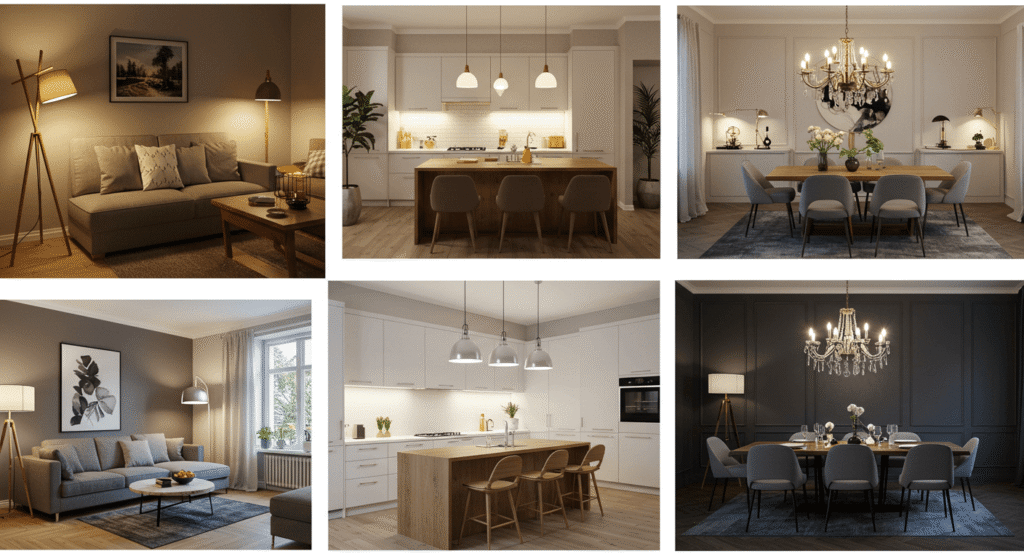
When exploring energy-saving lighting ideas, it’s easy to get overwhelmed by the number of bulb types and features on the market. But understanding the basic differences between the most common lighting options—LED, CFL, and incandescent—can help you make smarter choices that balance performance, efficiency, and ambiance. Let’s break down the options and highlight the ones that truly work best for saving both energy and money.
LED vs. CFL vs. Incandescent: Pros and Cons Table
Each bulb type offers something different in terms of cost, lifespan, and energy use. While LED lighting leads the way in efficiency, CFLs can still be a good option for certain areas, and incandescent bulbs—though outdated—are still used in some homes. Here’s how they compare:
| Bulb Type | Pros | Cons |
|---|---|---|
| LED | Highly energy-efficient, long lifespan, instant full brightness | Slightly higher upfront cost |
| CFL | Affordable, moderate efficiency, widely available | Contains small amount of mercury, slower to warm up |
| Incandescent | Cheap upfront, warm familiar glow | Short lifespan, high energy use, outdated tech |
Choosing LEDs is almost always the best long-term solution when you’re looking to implement smart energy-saving lighting ideas across your home.
How Dimmable Lights Can Save You More Than You Think
Dimmable lighting isn’t just about setting the mood—it’s also an underrated way to cut down on energy consumption. Lowering the brightness of your lights reduces the amount of power they use, especially if you’re using dimmable LED bulbs paired with compatible switches. This flexibility not only saves energy but can also extend the lifespan of the bulbs.
By dimming lights in areas where full brightness isn’t necessary—like hallways, dining rooms, or bedrooms—you can reduce your energy usage without compromising comfort or visibility. It’s a smart way to take more control over your lighting costs.
Choosing the Right Light Color Temperature for Energy Efficiency and Comfort
Light color temperature isn’t just a design choice—it affects how we feel and how efficiently we use lighting. Color temperature is measured in Kelvin (K), and here’s a quick guide:
| Temperature (Kelvin) | Light Appearance | Best Used In |
|---|---|---|
| 2700K–3000K | Warm White | Bedrooms, living rooms |
| 3500K–4100K | Cool White/Neutral | Kitchens, bathrooms, offices |
| 5000K–6500K | Daylight (Bright White) | Garages, outdoor spaces |
Warmer lights are ideal for relaxing spaces, while cooler temperatures can improve focus in task-heavy areas. Choosing the right tone means you’ll use lighting more efficiently—avoiding over-lighting or under-lighting a room, both of which can waste energy.
Smart Lighting Controls That Put You in Charge
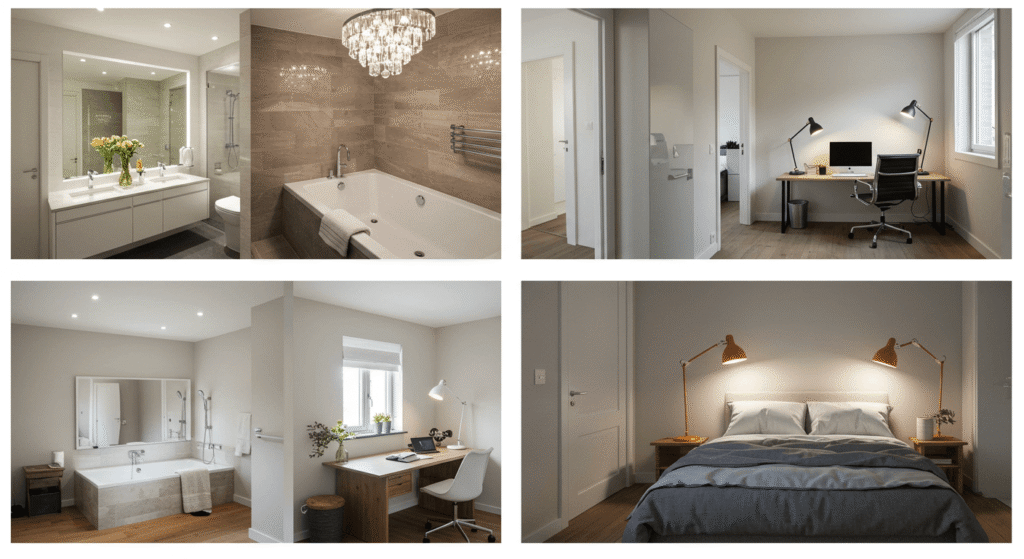
Taking control of your home’s lighting with smart lighting controls is one of the most effective ways to implement energy-saving lighting ideas. These controls help you use light only when and where it’s needed, eliminating waste and reducing energy bills without sacrificing convenience or comfort. Let’s explore how timers, motion sensors, and simple automation can make your lighting smarter and your home greener.
How Timers and Motion Sensors Cut Wasteful Lighting
Timers and motion sensors are simple yet powerful tools that prevent lights from being left on unnecessarily. Timers allow you to schedule your lights to turn off automatically at set times, perfect for rooms that are used on predictable schedules, like porches or home offices. Motion sensors detect movement and turn lights on only when someone is present, making them ideal for closets, hallways, and bathrooms.
By limiting the time your lights are on, these devices significantly reduce energy waste. Plus, they add a layer of convenience by removing the need to manually switch lights off.
Simple Automation Tricks for Energy-Savvy Lighting
Automation doesn’t have to be complicated. Basic setups like linking indoor lighting to your daily routine or using smartphone apps to control your lights remotely can result in substantial energy savings. For example, programming lights to dim during the evening or to turn off when you leave the house ensures you’re never paying for unused light.
Incorporating sensors that adjust lighting based on natural daylight can also reduce reliance on artificial lighting during the day, optimizing energy use seamlessly and smartly.
When and Where to Use Lighting Controls for Maximum Savings
Not every space in your home requires the same lighting controls. For example, motion sensors work best in areas with sporadic use, such as bathrooms, laundry rooms, and garages, while timers are ideal for outdoor lighting and common areas like living rooms or kitchens.
Strategically placing controls where they’ll have the greatest impact ensures maximum savings without inconvenience. This thoughtful approach to energy-efficient lighting turns your entire home into a smart, responsive environment that adapts to your lifestyle.
Let the Sun Shine In: Daylight Harvesting Techniques
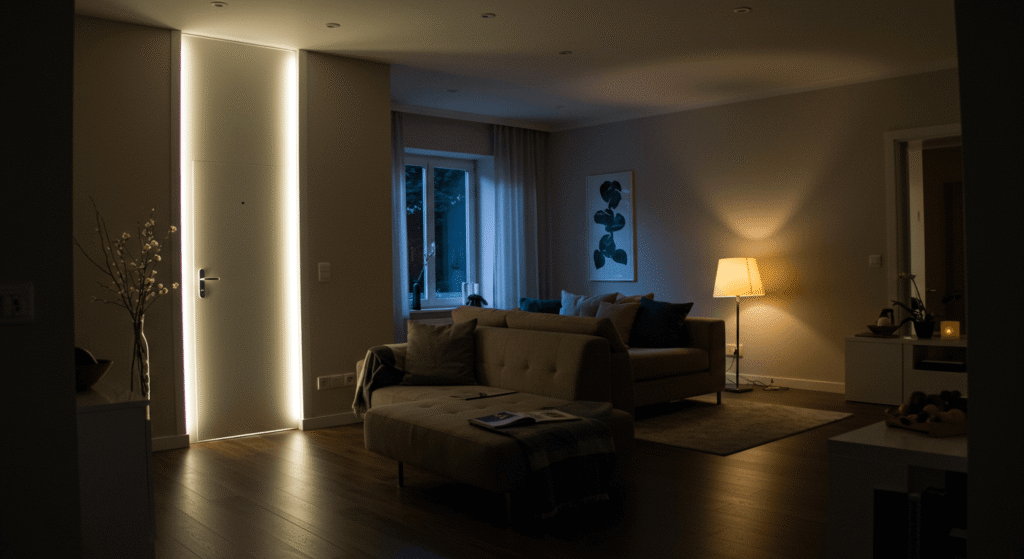
Harnessing natural light is one of the smartest energy-saving lighting ideas you can implement at home. By maximizing sunlight during the day, you can significantly reduce your reliance on artificial lighting, lowering your energy consumption and creating a more pleasant, uplifting environment. Let’s dive into how daylight harvesting works and ways to optimize it in your space.
Using Natural Light to Reduce Artificial Lighting Needs
Daylight harvesting means using the sun’s light to illuminate your rooms as much as possible. Positioning workspaces and living areas near windows or skylights lets you benefit from bright, natural light during daytime hours. The goal is to reduce the hours artificial lights are turned on, which directly lowers your electricity usage.
Simple steps like keeping windows clean, using light-colored walls, and minimizing heavy curtains can maximize the amount of natural light entering your home. This approach not only saves energy but also enhances mood and productivity.
How Window Placement and Treatments Affect Your Lighting Efficiency
The placement and size of windows greatly influence how much daylight you can capture. South-facing windows tend to provide the most consistent light throughout the day, while east- and west-facing windows offer morning or afternoon light, respectively. Thoughtful window placement during home design or renovation can drastically improve natural lighting.
Window treatments also play a crucial role. Adjustable blinds and shades let you control glare and heat gain, preventing rooms from becoming too bright or warm while still allowing sufficient light inside. Using reflective surfaces or light shelves can further distribute daylight deeper into your rooms, reducing the need for electric lighting.
Seasonal Lighting Adjustments to Save Energy Year-Round
Daylight availability shifts with the seasons, so adapting your lighting habits accordingly can optimize energy savings. In winter months, when daylight hours are shorter, supplementing natural light with energy-efficient bulbs during late afternoons and evenings is essential. During summer, you can rely heavily on daylight and use timers or sensors to minimize artificial lighting.
Adjusting your window treatments seasonally—opening them wide in winter and partially closing them during summer heat—helps balance natural light, reduce glare, and control indoor temperatures, all contributing to better overall lighting efficiency.
Energy-Saving Lighting for Every Room: Tailored Tips
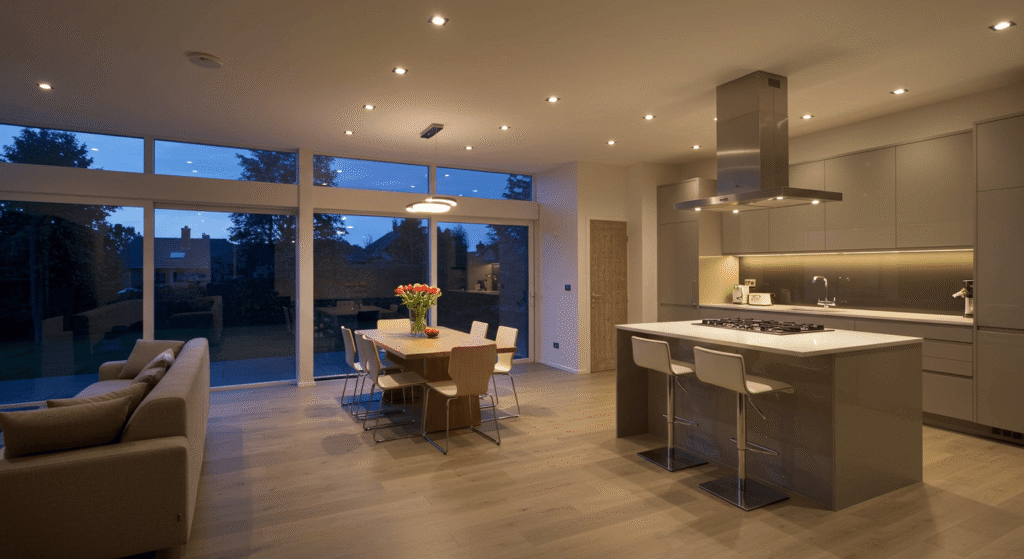
Every room in your home has unique lighting needs, and applying energy-saving lighting ideas effectively means tailoring your approach to each space. From the lively kitchen to relaxing bedrooms and practical outdoor areas, the right lighting choices can boost comfort, enhance functionality, and cut energy waste. Let’s explore how to customize your lighting strategy for maximum benefit.
Living Room and Kitchen: Bright and Efficient Zones
The living room and kitchen are typically high-traffic, multifunctional spaces that require bright, reliable lighting. Using energy-efficient LED bulbs with adjustable brightness helps create a flexible atmosphere—whether you’re cooking, entertaining, or relaxing. Consider layering light sources by combining overhead lights with task and accent lighting to avoid over-illumination and reduce energy consumption.
In kitchens especially, focus on task lighting over counters and work areas, where clear visibility is essential. Using dimmable LEDs here lets you lower brightness when full power isn’t needed, saving energy without sacrificing function.
Bedrooms and Bathrooms: Soft Light, Big Savings
Bedrooms and bathrooms benefit from softer, more calming light tones that encourage relaxation and rest. Opt for warm color temperatures with energy-saving bulbs to create a soothing atmosphere while still keeping energy costs low.
Installing motion sensor lights in bathrooms can prevent lights from being left on unnecessarily. For bedrooms, bedside lamps with dimmers or timers allow you to control light levels and duration, further reducing energy use while enhancing comfort.
Outdoor Lighting: Safe, Smart, and Sustainable
Outdoor lighting must balance safety with energy efficiency. Use smart lighting controls like motion sensors and timers to ensure lights only come on when needed, such as when someone approaches your front door or moves around your yard at night.
Choose fixtures that direct light downward to avoid wasting energy by illuminating the night sky unnecessarily. Solar-powered lights can also be a sustainable addition, capturing free energy during the day to brighten pathways and patios at night without drawing from your electricity bill.
Simple Swaps That Make a Huge Difference
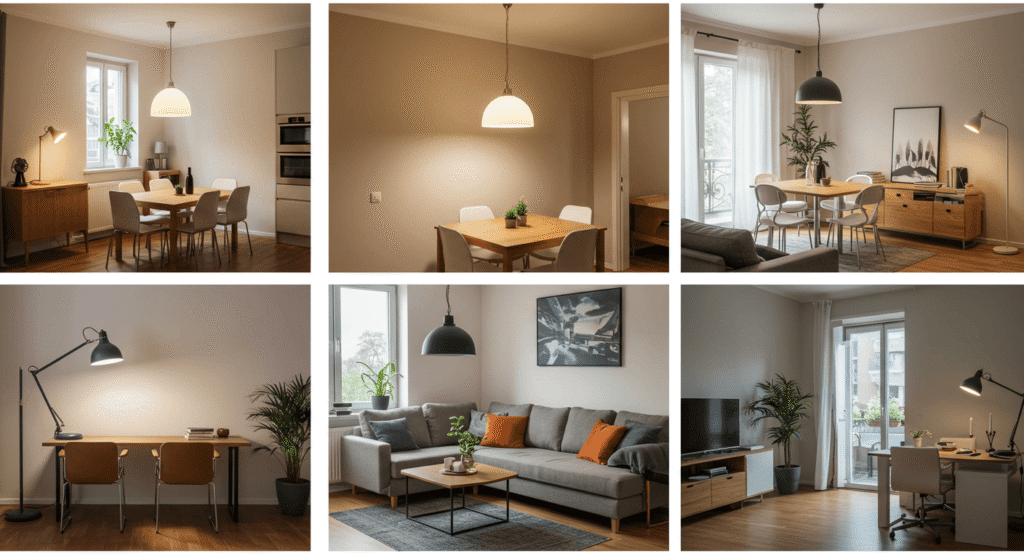
Sometimes, the easiest energy-saving lighting ideas are the most effective. Simple changes like swapping out bulbs or upgrading fixtures can lead to significant energy savings without the hassle of a full overhaul. Let’s look at practical swaps that can slash your energy use and boost lighting quality without breaking the bank.
Quick and Affordable Bulb Upgrades That Slash Energy Use
Switching out traditional incandescent bulbs for energy-efficient LED bulbs is the fastest way to cut your lighting energy consumption. LEDs use up to 80% less energy and last much longer, meaning fewer replacements and lower costs over time.
Additionally, swapping out bulbs in frequently used rooms or high-wattage fixtures has an outsized impact on your electricity bill. Even replacing bulbs in just a few key areas can reduce your home’s lighting energy use significantly.
Replacing Fixtures vs. Bulbs: What’s More Cost-Effective?
While upgrading bulbs is usually the easiest and most affordable way to improve energy efficiency, sometimes old fixtures themselves can be a source of wasted energy. Fixtures designed for outdated bulbs may not distribute light effectively or may limit your ability to use newer, more efficient bulbs.
In many cases, simply replacing bulbs is the most cost-effective choice. However, if fixtures are outdated, damaged, or incompatible with energy-saving bulbs, investing in new, modern fixtures can provide better light output and further reduce energy use.
When to Invest in New Fixtures for Maximum Return
Consider investing in new fixtures if your current ones are over 15 years old, show signs of wear, or don’t support dimmable or LED bulbs. New fixtures often come with built-in energy-efficient features like integrated LEDs or motion sensors, amplifying your savings.
Upgrading fixtures in high-use areas like kitchens, bathrooms, or outdoor spaces delivers the greatest return. When paired with efficient bulbs and smart controls, new fixtures become a powerful part of a holistic energy-saving lighting strategy.
Monitoring and Measuring Your Lighting Energy Use
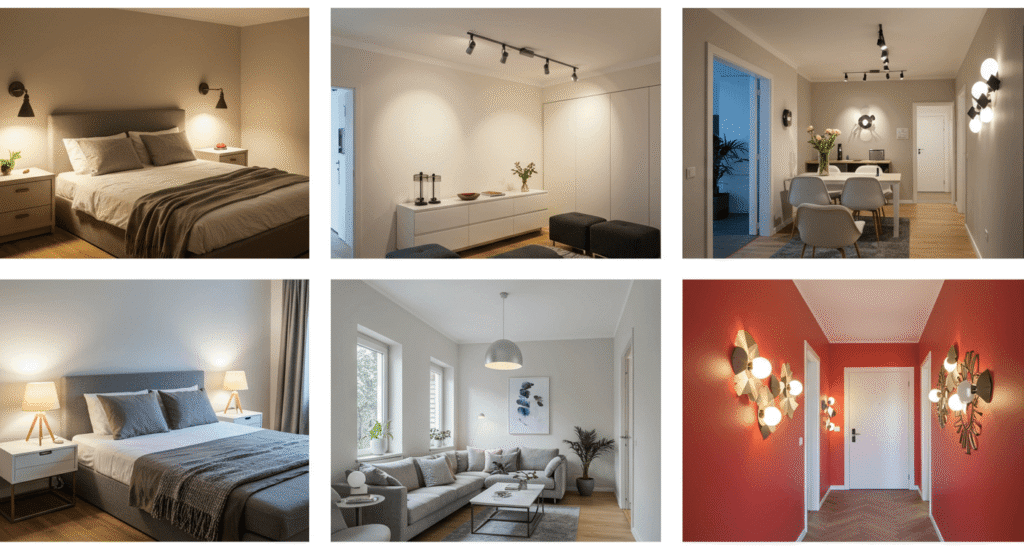
To truly maximize your energy-saving lighting ideas, it’s essential to monitor and measure how much energy your lighting consumes. Understanding your current usage gives you a clear baseline, helps identify problem areas, and tracks the effectiveness of any upgrades you implement. Let’s explore simple ways to keep tabs on your lighting energy use.
How to Track Your Lighting Energy Consumption Easily
Tracking your lighting energy use doesn’t have to be complicated. Many homes can benefit from affordable plug-in energy monitors that measure the power consumption of individual lamps or fixtures. These devices provide real-time data and cumulative usage, helping you spot which lights consume the most energy.
Another simple method is reviewing your electricity bills regularly, especially after making lighting changes. You can calculate estimated savings by comparing monthly usage before and after upgrades, giving you tangible proof of your energy-saving efforts.
DIY Energy Audit Checklist for Your Home Lighting
Performing a DIY energy audit for your lighting system helps you identify where energy is being wasted and which improvements will have the biggest impact. Here’s a quick checklist to guide you:
- List all lighting fixtures in each room
- Note the type and wattage of bulbs used
- Check for any lights left on unnecessarily
- Identify areas where natural light could replace artificial light
- Assess whether timers, dimmers, or sensors are installed
- Record any drafts or insulation issues near lighting fixtures that might affect energy use
Regularly updating this checklist after upgrades helps you track progress and maintain efficiency.
Visual Tools: Sample Energy Savings Chart After Lighting Upgrades
Visual aids like charts and graphs can make tracking your lighting energy savings easier and more motivating. For example, a simple bar chart comparing your monthly energy use before and after switching to LED bulbs or installing smart controls can clearly show the impact of your efforts.
Including such charts in your home energy journal or app helps keep you engaged and encourages ongoing improvements. Seeing the numbers drop over time makes the benefits of energy-efficient lighting feel real and rewarding.
Future-Proofing Your Home Lighting: What’s Next?
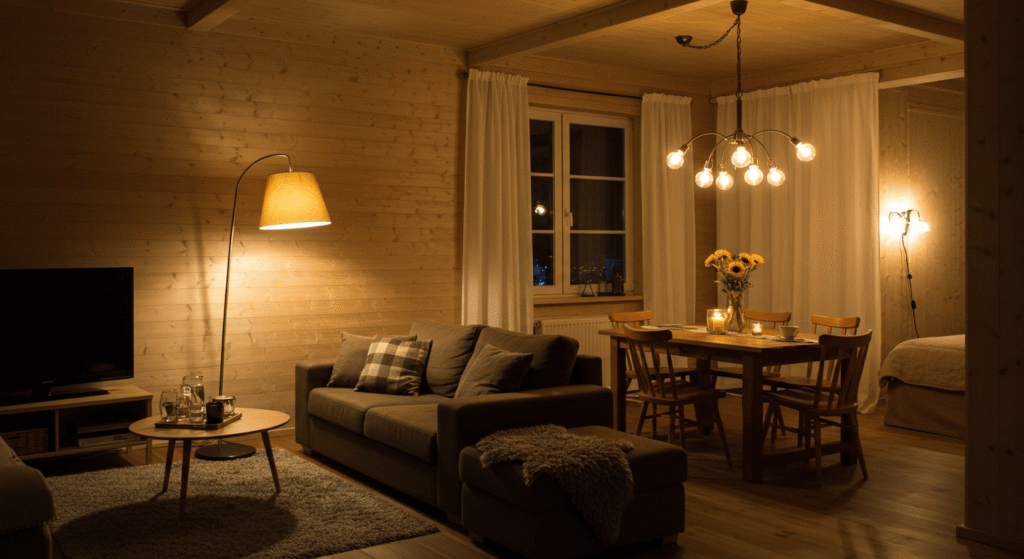
As technology advances, so do opportunities to make your home lighting even more energy-efficient and user-friendly. Future-proofing your lighting means thinking ahead—choosing solutions that not only save energy today but also adapt to tomorrow’s innovations. Let’s explore emerging trends and smart strategies to keep your home lighting efficient for years to come.
Emerging Trends in Energy-Efficient Lighting Technology
The lighting industry is evolving rapidly, with new technologies promising greater efficiency and convenience. Innovations such as tunable LEDs that adjust color and brightness throughout the day, wireless controls that sync with home automation systems, and ultra-low-energy lighting materials are reshaping how we light our homes.
These technologies offer enhanced comfort, improved mood regulation, and even health benefits, all while pushing energy savings further than ever before.
How to Plan Lighting Upgrades That Stay Efficient for Years
When upgrading your lighting, prioritize flexibility and compatibility with future tech. Choose fixtures and bulbs that support dimming, color tuning, and wireless control. Opt for modular systems where components can be easily updated without full replacement.
Planning your lighting upgrades with scalability in mind ensures you won’t have to redo your setup frequently, saving both money and resources over time.
Preparing Your Home for Smart Lighting Integration
Smart lighting integration is no longer a luxury—it’s becoming a standard feature in modern homes. Preparing your home involves ensuring reliable Wi-Fi coverage, using compatible wiring or wireless systems, and selecting lighting solutions that can communicate with your existing smart home devices.
This readiness makes it easy to add new features later, such as voice control, advanced scheduling, or integration with other smart appliances, creating a seamless and energy-efficient living environment.
Energy-Saving Lighting Ideas That Transform Your Home and Cut Costs
Embracing energy-saving lighting ideas is one of the most effective ways to brighten your home while reducing your energy bills and environmental impact. From choosing the right bulbs and using smart controls to harnessing natural light and planning for future upgrades, every small change adds up to big savings. By taking control of your home’s lighting now, you not only improve comfort and style but also contribute to a more sustainable lifestyle—making your home smarter, greener, and more cost-efficient for years to come.

